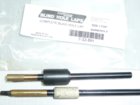Unless you are measuring using the same piece of brass, or taking an average, you can’t rely on your finished neck widths measurements. Each piece of brass sizes differently, even if from the same batch and annealed with an Amp. Also, I have found that I have had to adjust my Amp setting to get the results I am looking for. Even then, judging by feel, some pieces of brass size differently. Additionally, brass sizes and responds to annealing differently the more time it is fired. Pin gauges will not solve this problem because some pieces spring back, and I believe out also, differently.
I finally decided to rely on what I see on paper and velocity to weed out the liberal pieces.

I use pin gauges and think they have their place. I don’t think they are helpful if you don’t weed out the detractors.
Drano38 - Thanks for the response. Really appreciate the detail there, and I'm looking to do the same.
Ccrider - I was taking an average of 3 pieces sized. The motivation behind the analysis on the bushing is from what I see on target. Long story, but I'm reloading for a 6mmGT built off a Panda/Bartlein/60x golden eagle and having trouble consistently getting tighter than ~.4 MOA @ 215 yards. Meanwhile I can take my TR rifle or really any other gun I've got dialed and shoot tighter than that. So far I'm at 190 rounds through the gun, 4 powders, and 2 bullets.
I don't have any 6mm expirence, but generally my observations have led me to believe I should be able to expect significantly tighter groups than what I'm getting; not that I choose loads based on this, but my SDs are also higher than normal too. That led me down the path of looking at neck tension, as the gun seemed to shoot the best on virgin turned brass (i.e. off the .002 expander mandrel).
Generally speaking, I've found that lighter neck tension *usually* shoots better, and I knew the bushing was putting more than .001 on the brass due to feel when seating, but didn't think to go back and check the actual sizing amount until I just couldn't get the thing to shoot.
So here we are...measuring bushings, and ordering mandrels.

As far as next steps, I've sized 60 pieces of brass using each bushing (10 using .269, 10 using .268 etc.), and I've also sized a piece of brass down with a FL 6mm die, and opened it back up with a .262 expander mandrel.
I'm going to select my two best bullet/powder comobso so far, and load 5 of each for each bushing size.
I'll shoot them to see if that tells me anything about tension being a factor in this rifle not meeting accuracy expectations.











